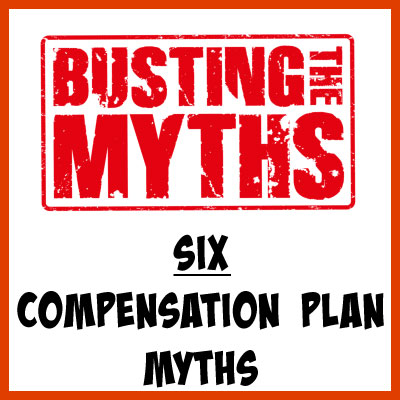 A myth is something many people believe to be true, but it’s not. Sometimes if you believe a myth, you can get hurt.
A myth is something many people believe to be true, but it’s not. Sometimes if you believe a myth, you can get hurt.
Myth #1: Simple Is Better
Almost everyone wants their compensation plan to be simple. There is a widely held belief that compensation plans don’t need to be so complex. If only it were so.
There is only one good thing about simple compensation plans and that is, they can be explained easily. Other than that, simple plans are bad for your business and the business of your independent representatives.
This is because simple compensation plans don’t motivate and reward the 12 essential behaviors that we want from your sales force.
If you look at the compensation plans of successful companies, you will see that none of them are simple.
Myth #2: Most People Will Recruit
“This business is all about recruiting. That means everyone who joins my company (or almost everyone) will recruit others. That’s a fact.”
Actually, that’s a myth! The truth is that most people won’t ever recruit, but fortunately, some of them will.
For direct selling companies who discourage joining just for product discounts, the percentage who will recruit at least one will fall between 15% and 35%. If your barrier to entry is low and people will join just to save money when they order your products, your rate of recruiting may be less than 15%.
If your compensation plan is designed based on the assumption that almost everyone will recruit, you will have a big problem.
Myth #3: I Should Borrow Another Company’s Plan
“If it’s good for company ABC who is successful, then if I borrow their plan perhaps with a few changes, that means I will be successful, too.”
Nope, that is myth #3. The compensation plan is an important ingredient in the recipe for success, but it’s not the only ingredient, and using another company’s plan can turn out to be a very bad business decision.
If you do this, you are assuming your company will make the same decisions the other company made when its plan was designed. Here is the problem… You don’t have enough information to know whether these decisions that were made by others for their company are appropriate for you and your company.
So, when can I use another company’s compensation plan?
Myth #4: I Should Build My Own Plan
Designing a compensation plan is a lot like building a new house. For your home to be structurally sound, financially affordable, legally compliant with building codes, and designed to last your family for years as it grows and its needs change, it’s wise to have experts design your home and other experts to build it.
The average Joe or Jill doesn’t have the skills and experience to be able to design a compensation plan that will work well to attract and compensate new reps, encourage and reward leadership development, and provide the ability to generate full-time income and more for top performers. The majority of people do not know how to design a legal compensation plan either, because they don’t know the laws.
That’s why most people don’t build their own houses or design their own compensation plans. When a compensation plan is needed, they hire a direct selling expert.
Myth #5: I Should Patent My Compensation Plan
A patent is an exclusive right granted by a government to an inventor to manufacture, use, or sell an invention for a specific number of years.
The purpose of a patent is to protect your invention by preventing others from benefiting financially from it. Patents are granted for new inventions or new uses of inventions.
Multilevel compensation plans are built with components, almost all of which have been used before by other companies. So, it would be very difficult to obtain a patent on your compensation plan unless it was so different from others in all aspects. And if it was so different, it would probably not be very good.
You may have read about compensation plans that are “patent pending.” This means a patent application was filed for a plan. It doesn’t mean a patent was granted or ever will be.
Don’t waste your time filing a patent application for your compensation plan.
Myth #6: Matrix Compensation Plans Are Good
There are different types of compensation plans. One of them is a “matrix.”
Matrix compensation plans operate with a structure that limits the number of representatives who can be placed on the first level. With a matrix compensation plan, the upline helps to build the downline. This is called “spillover.”
For example, if a company used a 3×5 matrix, each representative would have, at most, three representatives placed on his first level. Each of the three positions immediately below a representative can be filled by the representative or by an upline representative.
When the first level is full, the sponsor chooses specifically where to place a newly enrolled representative, or direct selling software can place the new representative in the first open position.
I believe that history is a good teacher. Do you know how many direct selling companies with matrix compensation plans have made it to their 10th birthday?
The answer is one and that one, Melaleuca, uses the enrollment structure for qualification requirements. The matrix structure is used only for placement. Every other company that has chosen to use a matrix compensation plan has lived a short life.
There is a reason for this, and that is, if you tell your reps they don’t have to work very hard due to spillover, they will listen to you. Not working hard is exactly what you don’t want them to do.
Conclusion
The best way to prevent these and other compensation plan myths from endangering your company is to hire compensation plan expert Jay Leisner at Sylvina Consulting to improve or design your compensation plan.

 Jay Leisner, the President of Sylvina Consulting, is a top compensation plan and direct selling expert, a trusted adviser to new and established network marketing and party plan companies. For more than 30 years, Jay has enjoyed assessing and improving network marketing, party plan and referral marketing companies across the globe.
Jay Leisner, the President of Sylvina Consulting, is a top compensation plan and direct selling expert, a trusted adviser to new and established network marketing and party plan companies. For more than 30 years, Jay has enjoyed assessing and improving network marketing, party plan and referral marketing companies across the globe.
Leave a Reply